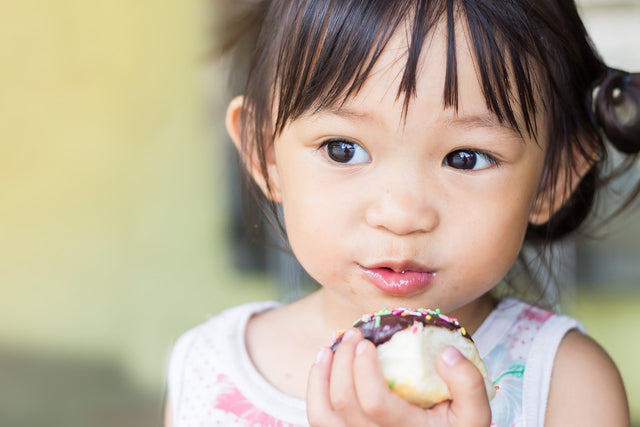24-Month-Old Baby Milestones

On This Page
Feeling mixed emotions about your child turning two? Despite the catchy phrase, 2-year-olds are not terrible—they just have huge emotions. But, there is an upside to that: At 24 months, your child probably offers some of the best hugs, biggest smiles, and cutest conversations imaginable!
With your child’s receptive and expressive communication skills constantly improving, you two now have the benefit of speaking the same language. Just remember that few people—and almost no toddler in the history of toddlers—can calmly and rationally listen to sage advice in a moment of anger. If your kiddo is melting down or lashing out, the Fast-Food Rule is the better strategy: Listen, repeat back what they’re expressing (“you’re mad… mad!”), and then talk through it when the heated moment lost some steam (you’ve probably had lots of chances to practice this skill over the past 6 months…and you’ll have many more in the coming year!).
One very pleasant thing about 2-year-olds? They don’t tend to hold grudges! Sure, they can be unhappy (explosive, even) in the moment. But, before you know it, they’ll go back to thinking you’re a superhero.
24-Month-Old Milestones Checklist
Here’s a list of milestones most kids (that means 75% or more) can do by 24 months, according to the Centers for Disease Control and Prevention…
Social and Emotional Milestones
- Notices when others are hurt or upset
Language and Communication Milestones
- Points to proper objects in a book when you ask
- Strings at least two words together, like “more milk”
- Points to at least two body parts when you asked
- Gestures beyond waving and pointing
Learning, Thinking, and Problem-Solving Milestones
- Holds something in one hand while using the other hand
- Attempts to use switches, knobs, or buttons on a toy
- Plays with two or more toys at the same time
Movement and Physical Development Milestones
- Kicks a ball
- Runs
- Walks (not climbs on all fours) up a few stairs with or without help
- Eats with a spoon
Your 2-Year-Old’s (24-Month-Old) Development
When kids begin to learn language, they start by assigning definitions to words for things they can see and feel, like mama, milk, ball, etc. By 24 months, your child is now moving onto understanding other words that make up language, such as prepositions—AKA location words such as in, on, above, below, before, after, etc.
Still, there is a difference between comprehending these words and accurately using them in conversation. Your 2-year-old is right on track if they are beginning to use simple, two-word sentences. No need to play Grammar Police! Rather than correcting their syntax or word choice, just repeat their phrase as a full sentence. For example, if your child says “me go,” respond by saying, “Yes, it’s time for Ben to go home. I’ll go home, too!”
Your child’s artistic skills are likely also developing… at least a little. They should be able to etch lines and curves but may prefer what is known as controlled scribbling. That’s a step up from random scribbling! If your kiddo doesn’t show any interest in art at this point, don’t push it. (Which is generally good advice with 2-year-olds!)
Your 2-Year-Old’s Growth
After so much physical growth during the first year of life, the pace has slowed down now. The average 2-year-old weighs around 26 pounds and stands more than 33 inches tall—with many kids on the smaller or larger sides of the spectrum. In the next year, they may only gain a few more pounds and inches. The main thing to look for, with help from their pediatrician, is a stable growth chart.
Two-year-olds are famous for their energy. With this, too, there is a spectrum. Some kids are naturally more high-energy while others conserve their pep for moments when they really need it. If your 24-month-old takes after the Energizer Bunny, be sure to offer ample opportunities to get physically active in a safe environment. Although their physical abilities have improved greatly during the past year, they don’t yet have the self-control or awareness to always use common sense!
Feeding Your 2-Year-Old
No problem if cake is on the menu for your child’s 2nd birthday—but keep in mind that the American Academy of Pediatrics recommends reducing your toddler’s fat intake to less than 30% of their daily calories at this age and to continue to limit their sugar intake. As you make that transition, here’s what else to keep in mind about your 2-year-old’s diet.
- Although your child should be able to exclusively self-feed at this point, choking remains a hazard. Some unsafe toddler foods that are best to avoid include hot dogs, nuts, stone fruit, hard candies, popcorn, whole grapes, and large chunks of meat or vegetables.
- Offer your child well-balanced meals that include protein, whole grains, fruits, vegetables, and dairy products. If your child has any dietary restrictions, ask their pediatrician about supplements—especially for iron and calcium.
- If your once-good eater is developing some picky habits, know that’s common at this stage! Battling it out over eating a full plate of vegetables is in no one’s best interest. Instead, look for win-win compromises while continuing to offer options you hope they’ll come around to again.
< 23-Month Milestones | More Toddler Tips >
***
REFERENCES
- The Happiest Toddler on the Block, Dr. Harvey Karp, MD
- Zero-to-Three: Learning to Write and Draw
- Centers for Disease Control and Prevention: 2-Year Milestones
- Centers for Disease Control and Prevention: WHO Growth Charts
- The American Academy of Pediatrics: Feeding and Nutrition Tips for Your 2-Year-Old